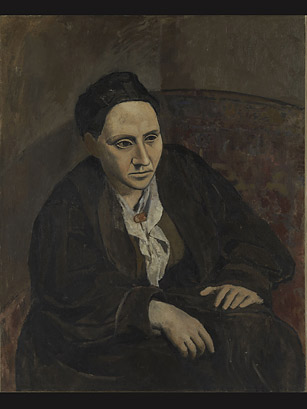
Outside of Academia, does anybody read Gertrude Stein anymore? Most of her major works are too strenuously experimental to be much fun. Better to remember her as the bohemian Buddha of Paris, where she and members of her family assembled the 20th century’s most fearless collections of modern art. “The Steins Collect: Matisse, Picasso and the Parisian Avant-Garde,” a phenomenal new show at the San Francisco Museum of Modern Art, gathers highlights of those hugely influential and long-dispersed collections for the first time in 41 years. Gertrude arrived in France as a medical-school dropout; her brother Leo had dabbled in law and zoology. Raised mostly in the San Francisco Bay Area, in Paris they found their vocation: as tastemakers. By 1903 the two were installed in the apartment at 27, rue de Fleurus that they would make the unlikely cockpit of the avant-garde. Soon their brother Michael and his wife Sarah set up house a few blocks away and dived into the galleries with them. When the Steins began collecting the most radical new art, Pablo Picasso was just 23 and still a relative unknown–but Henri Matisse was already notorious. In 1905 at the annual Salon d’Automne, he landed the ultimate blow against convention with Woman with a Hat, a portrait of his wife Amelie in which color had been set free from the chore of realistic description. One of her cheeks was a patch of yellow, the bridge of her nose a blue streak. Everyone laughed at it. Leo and Gertrude bought it. That purchase marked the beginning of the Steins’ role as evangels of early modernism. They went on to buy some of the pivotal works of Matisse’s early career, including his Fauvist provocation Le Bonheur de Vivre and his bluntly confrontational Blue Nude: Memory of Biskra. As their walls filled with pictures, both Stein households held open houses every Saturday where artists, writers and curiosity seekers could cast a wary eye on the new work and hear Leo, a budding theorist, elucidate its mysteries. “Some came to mock,” he once boasted, “and remained to pray.” Though Gertrude resisted Picasso’s art at first, he secured her allegiance during the many sittings for the great portrait in which he rendered her serene bulk as a kind of natural formation, weighty and enduring as a mesa. Their bond may help explain Gertrude’s willingness to follow Picasso and later Juan Gris as they ventured into the thickets of Cubism that Leo increasingly disliked. He could accept the Cubist-derived space in a canvas like La Rue-des-Bois, where solid form was still detectable. Full-bore Cubist perplexities like The Architect’s Table, which Gertrude bought on her own, Leo would reject as “utter abominations.” By 1914 the two were so estranged that Leo moved out. He took the Renoirs. She kept almost all the Picassos.